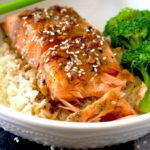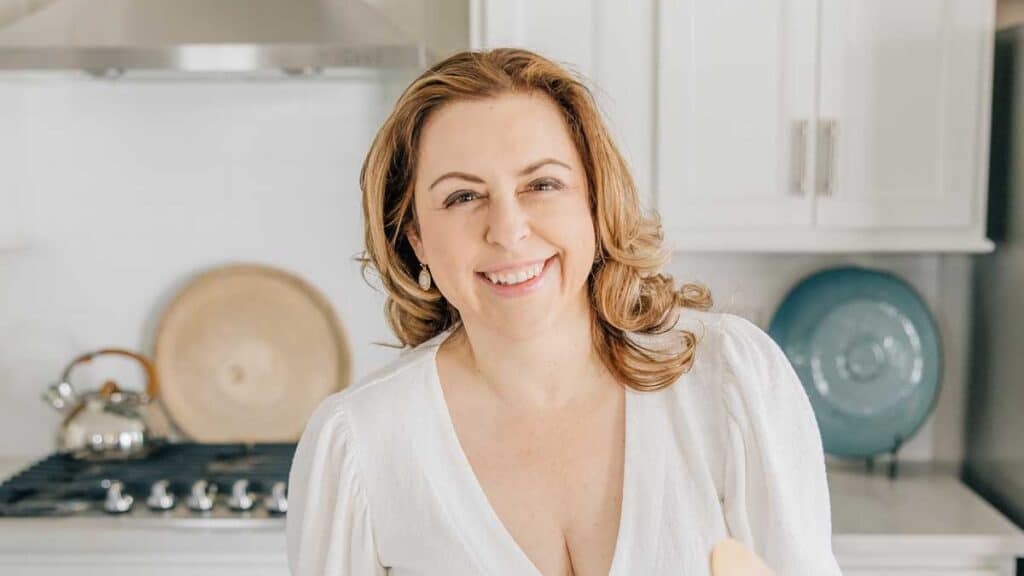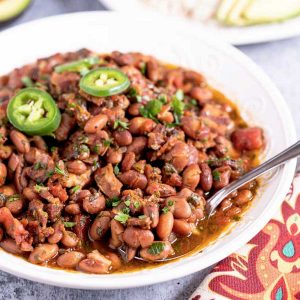Oven Baked Salmon with Honey Ginger Glaze is a quick, easy and healthy recipe great for when you need an impressive restaurant-quality meal made in 20 minutes! The caramelized honey ginger glaze is lip-smacking delicious and adds so much flavor to the flaky baked fish.
Easy baked salmon recipes are a great healthy dinner option that always feel as if you are celebrating a special occasion. Check our Lemon-Herb Butter Baked salmon recipe!

Baked Asian Salmon with Honey Ginger Glaze
This Asian inspired oven baked salmon may look fancy, but it’s actually one of my “lazy meals” or a dinner meal I prepare when I’m short on time or I don’t feel like cooking (yes! that happens more often than you might think).
The melt in your mouth sweet and savory honey ginger glaze is made with just a few simple ingredients and it adds so much flavor to the tender fish. You are going to want to pour this Honey Ginger glaze over grilled chicken, grilled salmon, pork chops or any other firm fish!
Why You Should Make This Salmon Recipe
- Quick to Make: Very little prep and short baking time means that you can have dinner ready in 20 minutes!
- Heathy: Salmon is a great source of protein with healthy fats and lots of nutrients. Use organic local honey for additional health benefits (local honey may help you if you suffer from seasonal allergies)
- One Pan Meal: This recipe bakes in a baking pan or sheet pan which means less dishes to clean and more time enjoying life!
What to Serve with Salmon
This Asian salmon recipe is great served with Stir Fry Bok Choy or Blanched Green Beans especially if you are trying to eat more low carb meals. We love serving it with rice, mashed potatoes or a side of simple Butter Pasta (my son loves that option!)

Is Salmon Good For You?
Salmon is praised for its high protein content and it is among the healthiest and most popular fish. This nutrient dense fish is loaded with brain-boosting and heart-healthy Omega-3 fatty acids as well as vitamins and minerals.
Salmon is said to reduce inflammation and fight some types of cancer. It also improves eye health, skin and hair health and helps improve mood and keep your energy levels up.
What Type of Salmon Should I Buy?
Salmon can be divided into two main categories based on their origin – Atlantic Salmon and Pacific Salmon. The first choice you need to make is if you want to buy wild salmon or farmed raised salmon. Although I prefer wild salmon, you can find good farmed salmon raised in a responsibly managed farm and without antibiotics.
Wild Salmon vs Farm-Raised Salmon:
Wild and farm-raised salmon are a good source of healthy protein. They do, however, have some nutritional differences. Wild salmon contains more minerals while farm-raised salmon is higher in fat. I suggest you always choose what is best for your budget.
Fresh Salmon vs Frozen Salmon:
Most fish is flash-frozen when caught. This preserves its freshness and allows transportation without any health risks.
Skin-On or Skinless Salmon:
Salmon skin is edible and keeps the fish moist while cooking. However, if you don’t like the taste you can remove it or ask your fish monger to do it for you. Keep in mind that the skin is much easier to remove when the fish is already cooked. It really just pulls off.
Asian Salmon Ingredients
- Salmon: For this recipe, you can use one large piece of salmon aka a side of salmon and then cutting it into smaller pieces, or you can use individual salmon fillets. You can use skin-on or skinless salmon. Atlantic salmon has a milder flavor than Alaskan sockeye.
- Butter: I think butter adds amazing flavor to salmon while keeping it moist. Since this recipe includes soy sauce, I prefer unsalted butter. However, I have made it with salted butter many times with good results.
- Soy Sauce: Adds umami to the dish. Use low sodium if you are sensitive to sodium.
- Honey: Any type of honey works. I usually always have organic local honey in my pantry.
- Mirin: Mirin is a type of rice wine but unlike sake, it has a low alcohol content and is a bit sweeter. There are good substitutions for mirin such as rice wine vinegar, sake, lemon juice or white wine vinegar with a little pinch of sugar.
- Ginger: I use fresh ginger but in a pinch you could use dry ginger.
- Garlic: I use fresh garlic but garlic paste found in the refrigerated area of the produce department is your next best option. As a last resort, use granulated garlic.
- Salt and Pepper: Fish loves salt and fish needs salt. Even when using soy sauce, you need salt when cooking fish.

How to Make Soy Ginger Salmon Glaze with Honey
For specific directions and times, check the recipe card below.
- Prep: Preheat the oven to 400 degrees Fahrenheit.
- Make the Honey Ginger Glaze: Melt the butter with the rest of the glaze ingredients. Simmer for about 3 minutes.
- Season: Season the salmon fillets lightly with salt and pepper. Don’t skip this step!
- Bake: Pour the Honey Ginger Glaze over the salmon and bake ( time will depend on the thickness of the fish). Serve.

Should I bake the salmon covered or uncovered?
For this recipe, I bake the salmon uncovered.
Can Soy Ginger Salmon be made ahead?
Salmon is best served when just made, but if you have leftovers they will keep in the refrigerator covered for 3 days.
How do you know when baked salmon is done?
You know that your salmon is perfectly cooked when the salmon flesh flakes easily. The meat should be relatively opaque with a bright pinkish center, tender and moist.
Why Should I Bake Salmon?
Baking salmon is easy and doesn’t require flipping or basting. This convenient and simple cooking method produces delicious, flaky and juicy salmon with very little effort.

At What Temp Should Salmon Be Baked?
Salmon is best cooked quickly at high temperature. I like baking salmon at 400 degrees Fahrenheit.
How Long To Bake Salmon?
Exact cooking times vary depending on the thickness of your salmon fillets. Typically, it takes about 12 to 15 minutes to cook a 1-inch thick piece of salmon in a preheated 400 degree oven. Wild salmon may take less time to bake as it has less fat and tends to get dry quicker than farm-raised salmon.
Perfectly cooked salmon should be flaky and have a bit of pink in the middle.
Storing and Reheating
Leftover salmon will keep in the refrigerator stored in an airtight container for 3 days. You can reheat it in a microwave in small intervals or in a preheated 300º F oven, covered until heated through.

Asian Salmon Recipe Tips and FAQs
- Substitute mirin with rice wine vinegar, sake, lemon juice or white wine vinegar with a little pinch of sugar
- Perfectly cooked salmon flakes easily. The flesh should be relatively opaque with a bright pinkish center.
- An instant-read thermometer inserted into the thickest part of the fillet should read 120°F to 130°F for medium-rare or 135°F to 145°F for medium and well-done.
- I have one rule when cooking salmon (a rule I never ever break). I always season the fish lightly with salt. No matter what preparation or what other seasonings I will be adding, I always start with salt. I think it helps to get rid of the fishy taste, but this is just a “gut feeling” and not something I learned at culinary school.
Check Out These Other Favorite Recipes:
Email me this recipe for later!

Asian Salmon with Honey Ginger Glaze
Ingredients
For the Glaze
- 4 tablespoons unsalted butter
- ¼ cup soy sauce (use low sodium if you are sensitive to sodium)
- 2 tablespoons honey
- 1 teaspoon mirin
- 1 (2-inch piece) fresh ginger, peeled and grated
- 2 garlic cloves, minced
The Salmon
- 4 (6 -ounces) salmon fillets (skin-on or skinless)
- Salt and pepper to taste
- Sesame seeds for garnishing, optional
Instructions
- Preheat the oven to 400 degrees Fahrenheit.
To Make the Honey Ginger Glaze
- In a small saucepan over low heat, melt the butter, add the soy sauce, honey, mirin, grated ginger and minced garlic. Mix to combine and simmer for about 3 minutes. Remove from the heat and let it cool for a couple of minutes.
Prepare the Salmon
- Line a baking sheet with aluminum foil or parchment paper. If using a baking dish, omit the aluminum foil/parchment paper. Spray with cooking spray or coat the bottom with a little bit of oil (olive oil or canola oil) to prevent the fish from sticking.
- Place the salmon on the sheet pan or baking dish (skin side down). Season the salmon fillets lightly with salt and pepper.
- Pour the Honey Ginger Glaze over the salmon, making sure both sides are coated with the glaze. Bake for 10 to 15 minutes (depending on the size and thickness of the fish) or until the salmon is cooked through and flakes easily.
- Remove from the oven and garnish with sesame seeds (optional). Serve.
Recipe Notes
- Cooking time will vary depending on the size and thickness of your salmon fillets.
- Cook until the salmon is cooked through but still a bit pink in the middle and flakes easily. About 12 to 15 minutes for every 1-inch thickness of salmon.
- An instant-read thermometer inserted into the thickest part of the fillet should read 120°F to 130°F for medium-rare or 135°F to 145°F for medium and well-done.










Leave a Reply